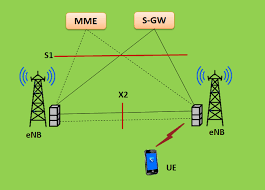

Base Station Controller.
image ©iotone.com
eNodeB in 4G.
image ©techtrained.comIn 2G the base station was made up of a Base Transceiver System and a Base Station Controller. In 4G the same function is carried out by the eNodeB, and in 5G this is called gNodeB. In each of these systems, the Base Station' role is to receive the data from the mobile station and sent it on it's way
The only part of a mobile system that is wireless is that between the mobile station and the mobile mast. The role of the base station is to manage this mobile transmission. Receiving data from a mobile station, or sending the data to the mobile station. It passes the data (or received the data) from the Managing Mobile Entity, which is part of the core network.
In addition the eNodeB has a managing function. It manages the interface between the wireless transmission and the core data. In a 4G (and 5G) network as many functions that can be carried out at the edge are done so, hence the eNodeB has significant management function to manage the communication to and from the mobile station and the wireless network. Functions such as frequency management, handover, and optimising the wireless network are included here.
© mobilephonetechnology.co.uk all rights reserved 2017-2025
